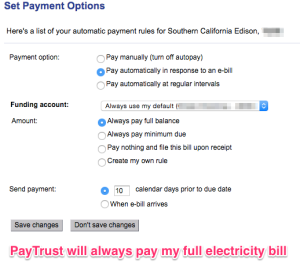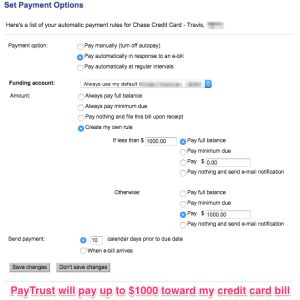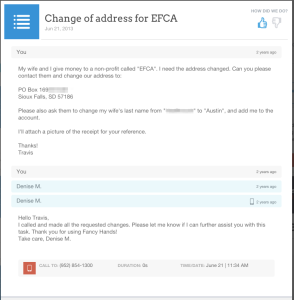When Laura and I got married, we moved into the condo she had owned for 9 years.I took responsibility to pay the bills for our new family as we settled into our new routine together.
All the utility and mortgage bills were set up before I entered the picture, so I had to get up to speed on how each bill was handled. I had a hard time remembering what bills got paid automatically, and which ones I needed to pay manually. For instance, when I got the bill for our electricity, I didn’t know if the electric company was going to automatically deduct the bill from our checking account. I didn’t know if we had an account on their website to log in and pay it; and I didn’t know if I should use our bank’s bill payment feature to pay the bill. It seemed like every bill was paid differently and I was constantly asking Laura how she handled each bill.
I tried to figure out a way to have everything paid through a single login, and I didn’t want to have to open the mail and go through the bills each month. If I used our bank bill pay to pay everything in a single control panel, then I would have to manually enter the dollar amounts for electricity, gas, and water each month. If I used the utility company websites to automatically deduct the charges from our checking account, then I would have to keep login information for the dozen-or-so bills set up that way. I didn’t want to enter the dollar amounts each month on our bank website and I didn’t like the idea of having login details for a dozen utility companies who were all taking money from my checking account each month.
Enter… PayTrust
I found PayTrust, a company that is now owned by Intuit, the makers of Quicken and QuickBooks. They started out years ago as PayMyBills.com, and I had heard of them back in 2008 but had never tried the service. Now, I was very interested in using them. For only $9.95 per month, PayTrust pays bills, but they also receive paper mail and open and scan any bills they receive!
PayTrust assigns you a unique PO box address (like PO Box 169899382, Sioux Falls SD 57186). Then you contact all the companies that send you bills and tell them to send the bills to your new PayTrust PO box. PayTrust opens all the mail that is sent to your new PO box, scans the mail into PDFs, and then pays the bills based on your standing instructions.

 I have PayTrust set up to always pay my electricity bill in full but pay only up to a certain amount for our credit card (in case we have an expensive month). If we get a bill from our doctor, PayTrust won’t pay it automatically, but will email me and ask me what to do. Basically, PayTrust is billing auto pilot.
I have PayTrust set up to always pay my electricity bill in full but pay only up to a certain amount for our credit card (in case we have an expensive month). If we get a bill from our doctor, PayTrust won’t pay it automatically, but will email me and ask me what to do. Basically, PayTrust is billing auto pilot.
Less Paperwork When We Moved
When I set up PayTrust, I wasn’t anticipating that it would make it easier when we bought a new house, but it did. When we moved last year, I didn’t need to change our address with our bank, our cell phone provider, or even the ministries we support. They were all sending our bills and statements to our PayTrust PO box, which wasn’t changing.
Better Management of Recurring Ministry Support
Laura and I support a few ministries (a.k.a. non-profits, charities) and PayTrust has made it easier with them, as well. They used to all draw from our checking account each month. That was convenient for them, but super inconvenient for me when I needed to change something. If I needed to change our bank account, or the date they were drawing funds, I would have to contact each ministry and get them to change it. That could take a few hours. Instead, I now have checks sent from PayTrust, and they all go out on the same day each month. If I need to change something, I am able to do that much more easily.
We Don’t Get Any More Bills
With PayTrust, we haven’t received a single mortgage, electricity, water, cable, or credit card bill at our house for over 2 years. The only mail we get at home now are wedding invitations and greeting cards.
Now the mail never piles up on the counter, we never make a late payment, and we never lose a bill. Everything is automatic and reliable.
I think that using PayTrust has helped my marriage, too. Laura and I don’t have any stress over the timing of paying our bills. We’ve never had trouble because one of us lost a bill, or forgot to pay one, or wondered if we missed a deadline.
I am a huge fan of automating a family’s bill payment processes, and I think PayTrust is currently the best way to get it done. This works great, also, for people who are handling the finances of a parent or loved one. Simply redirect all the bills to PayTrust so they never get lost and they always get paid, and you don’t have to “do the bills” every month.
Tomorrow, I’ll explain how I got my address changed to my PayTrust PO box for all my bills, without sending a single letter or making a single phone call (well, except for the first one). Stay tuned.
 I decided to use a task-based virtual assistant service called
I decided to use a task-based virtual assistant service called 

